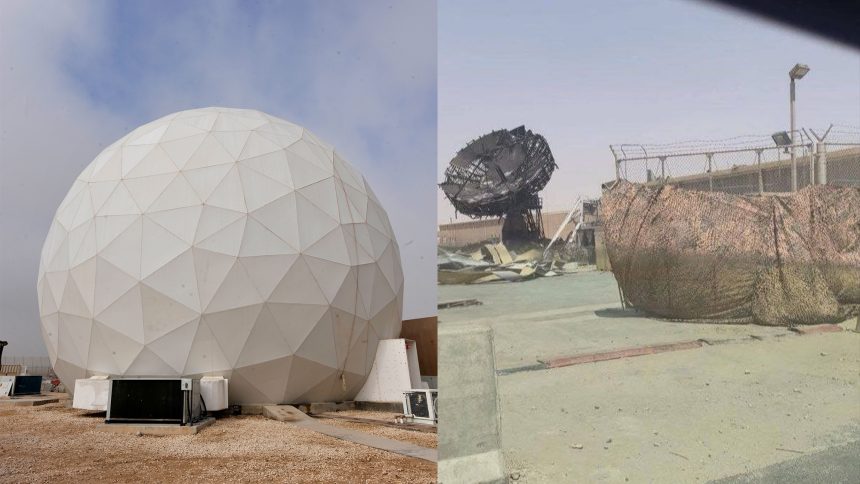Images showing a destroyed satellite antenna at Al Udeid, part of the Wideband Global SATCOM (WGS) network, have surfaced following earlier satellite imagery that revealed a radome had been hit by Iran’s Jun. 23, 2025 missile strikes.
Though no casualties were reported as a result of Iran’s missile attack on U.S. targets in the Middle East – a retaliation after Operation Midnight Hammer – we now know that some fairly significant damage was sustained at Al Udeid Air Base in Qatar. Most of Iran’s missiles were intercepted by air defense batteries, but at least one missile made it through the defensive shield.
Satellite images captured following the attack showed an area with scorch marks and debris which, on previous imagery, was the site of a geodesic radome. The radome and the antenna involved were quickly identified just from these images, but we now have a view from the ground of the stricken, burned antenna dish itself. Needless to say, the dish has been significantly damaged and much of the system will likely require total replacement.
Exclusive: A U.S. military radome was destroyed in Iran’s June 23 strike on Al Udeid. A detail absent from the Pentagon’s initial statements pic.twitter.com/8EYmxYGrWy
— Fardad Farahzad | فرداد فرحزاد (@FardadFarahzad) July 10, 2025
Al Udeid is a major hub of U.S. activity in the region, housing a forward headquarters for U.S. Central Command (CENTCOM), the 609th Air Operations Center, and a wide array of U.S. Air Force aircraft. As such, the base hosts a massive concentration of U.S. communications capabilities that allow information to be relayed between CENTCOM and commanders in the continental U.S. or with allies across the world effectively in real time.
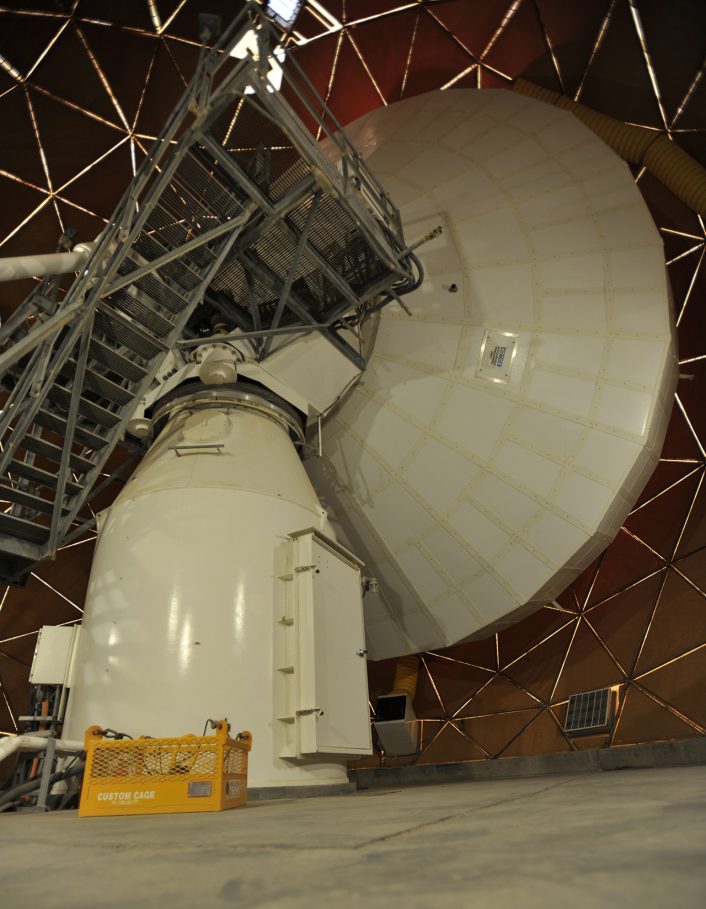
Part of this involves connecting to the U.S. Wideband Global Satellite Communications system (WGS), a new network, with satellites still being rolled out, using both Ka-band and X-band frequencies. WGS enables worldwide C4ISR (Command, Control, Communications, Computers, Intelligence, Surveillance, and Reconnaissance) for the U.S. as well as select partners, at a much higher capacity than legacy systems.
A single WGS satellite is said to offer a greater capacity for concurrent communications than the entire legacy Defense Satellite Communications System III (DSCS III) network combined. Ten WGS satellites have been launched to orbit, with WGS-11 expected to join them at some time this year.
Congratulations @usairforce, @ulalaunch & @Boeing on the 10th Wideband Global SATCOM launch aboard #DeltaIV on March 15. This latest satellite completes the WGS constellation, @AFSpace reports, providing high-capacity communications to the greatest fighting force in the galaxy pic.twitter.com/RBCCCCyDXV
— James Drew (@StrikeWriter) March 17, 2019
At Al Udeid, a dedicated antenna for connecting to this, and to the legacy systems which remain in use, was declared operational in January 2016. Referred to as the Modernized Enterprise Terminal (MET), and produced by L3Harris, the communications system was the first of its kind installed outside of the United States.
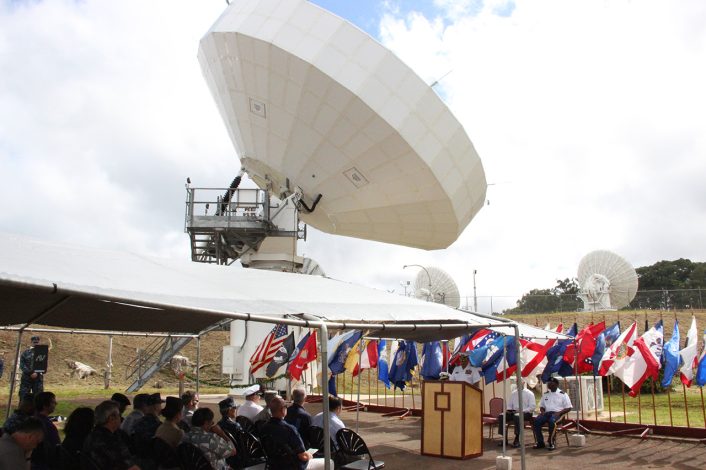
The specific designation of the dish antenna, which is one of several options offered by L3Harris in the MET family, appears to be AN/GSC-52B(V5). L3Harris calls it the Large Fixed Terminal, with a dish size of 12.2 metres. The first MET, complete with an AN/GSC-52B(V5) was installed at the Wahiawa Satellite Communications Facility in Hawaii in mid 2015. Unlike in Qatar, the dish in Hawaii is open to the elements and not protected by a radome.
Fixing the Damage
Replacing this dish will likely be a high priority for U.S. forces so that full communications capacity can be reinstated. While this effort is arranged and completed, it is possible that one of the smaller systems in the MET program might be deployed to the base as an interim solution – alternatively, one such system might be permanently positioned at Al Udeid or at another nearby CENTCOM base specifically to cover this eventuality.
There are two transportable satellite antennas, both 7.2 metres in diameter, offered by L3Harris as part of the MET program – a standard version and a hardened version. Both are trailer mounted, but the latter is housed within a radome. The performance of the smaller antennas can’t match that of the larger fixed terminal, but they would likely work as a stopgap solution.
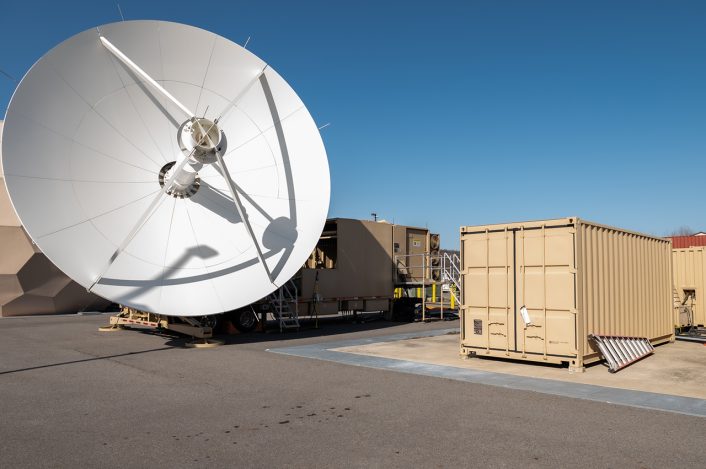
Although the target is less high profile than, for example, a U.S. Air Force aircraft on the tarmac, the apparent choice to strike this radome shows some smart decision making on Iran’s behalf. Unlike an aircraft, or any other type of vehicle, this radome is a fixed point that cannot be moved and evacuated. Additionally, reinforcing the structure to withstand an attack – as the U.S. Air Operations Centre at the base is likely to be – would not be possible without compromising the antenna’s communications capability.
However, in choosing this site Iran also lessened the likelihood of significant casualties, which would be a factor in potentially provoking a U.S. retaliation to their retaliation – this being said, we do not know where the missiles that were intercepted were targeting. And we do, of course, assume here that the radome was in fact targeted and not simply the result of a lucky hit.
U.S. officials have confirmed to CNN that non-sheltered USAF aircraft have been evacuated from Al Udeid Air Base in Qatar, and U.S. Navy vessels previously forward-deployed at Naval Support Activity Bahrain have also repositioned.
Additionally, medical logistics have been… pic.twitter.com/zi54fIhXpg
— GMI (@Global_Mil_Info) June 19, 2025
These vulnerabilities have undoubtedly been considered by the U.S. military, and mitigation measures (for example, the deployment of a transportable terminal) have almost certainly been planned for for many years, but even a small hit to their communications capacity at such an important location has the potential to be a major hindrance to ongoing operations.
Contrary to some reporting, including by Iranian media, the dish is not part of an early warning radar system, or any kind of radar system. Even without the knowledge of the antenna’s exact function, it is clear based on the position of the radome at ground level in the middle of a nest of buildings that it would be an unsuitable place to site a radar antenna.
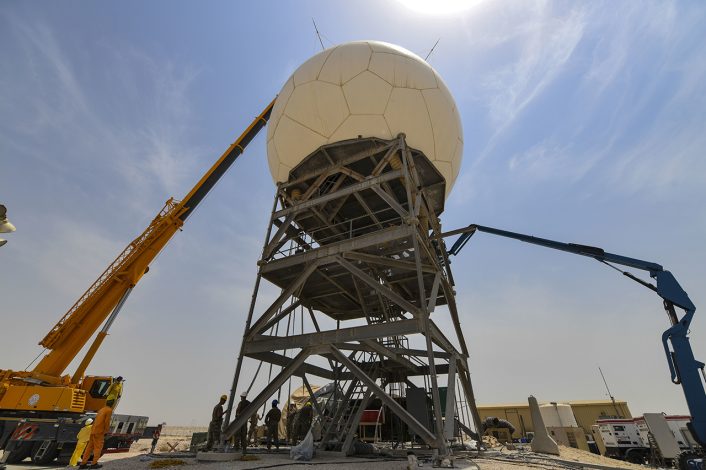
Workers in the nearby buildings would be within the radiation hazard zone, and buildings would restrict the radar’s view of lower altitudes – one of the most crucial zones for a radar to scan, especially in order to see aircraft at altitude at greater distances. For this reason, air traffic control radars – including one previously shown at Al Udeid – are usually housed on top of a tower.

